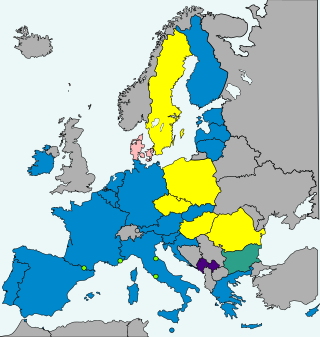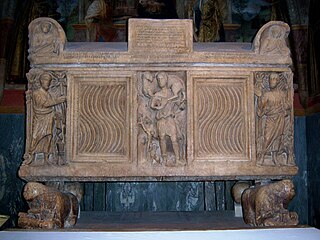
Sammarinese euro coins feature separate designs for every coin. All the coins are inscribed with the words "San Marino" and the twelve stars of the EU. The Sammarinese euro coins are minted by Istituto Poligrafico e Zecca dello Stato (IPZS), in Rome, Italy.

Vatican euro coins are issued by the Philatelic and Numismatic Office of the Vatican City State and minted by Istituto Poligrafico e Zecca dello Stato (IPZS), in Rome, Italy. The euro is the official currency of the Vatican City, although Vatican City is not a member of the Eurozone or the European Union. The euro has been the official currency of Vatican City since 2002. Before that, the Vatican lira was the official currency.
The commemorative coins of Italy are minted by the Istituto Poligrafico e Zecca dello Stato (IPZS) in Roma.
Zecca, Italian for "mint", may refer to:

Saint Catervus is the patron saint of Tolentino. Catervus is said to have brought the Christian faith to the city. Tolentino is known to have had bishops by the fifth century.

The Philatelic and Numismatic Office of the Vatican City State, managed by Poste Vaticane, is responsible for issuing Vatican postal stamps and Vatican coins.

The Gazzetta Ufficiale della Repubblica Italiana is the official journal of record of the Italian government. It is published by the Istituto Poligrafico e Zecca dello Stato in Rome.
Thesaurus Florentinus is a project for the acquisition and reconstruction of the images of the mural paintings in the Cupola of Santa Maria del Fiore in Florence and a computer system to manage the hundreds of thousand pieces of information gathered during the restoration campaign ended in 1995. The project was conceived by Arch. Riccardo Dalla Negra and realised by Lapo Bertini, Silvia Brotini, Auro Pampaloni, Marco Menichetti, Lara Calosi and Arianna Sacchetti with the technological support of IBM and Eastman Kodak and the financial support of the Ministero dei Beni Culturali of Italy and Ente Cassa di Risparmio di Firenze. The project started in 1992 and ended in 2000.

The Ministry of Enterprises and Made in Italy, commonly known under the shortening it's pre-2022 name MISE, is a government ministry of the Italian Republic. It deals with production, economic activities, energy and mineral resources, telecommunications, consumers, tourism, internationalisation and business incentives. It was formed in 2006 after the reorganization of the Ministry of Productive Activities to which were merged the Ministry of Communications and the Ministry of International Trade in 2008.

Giuseppe Cobolli Gigli was an Italian engineer and politician. From 1935 to 1939, he was member of Benito Mussolini's Italian fascist government as minister of public works.

The Ministry of Economy and Finance, also known by the acronym MEF, is a ministry of the Italian government. Its responsibilities include overseeing economic policy, public investments and spending. The Ministry's headquarters are located in Rome's historic Palazzo delle Finanze. The current minister in the Meloni Cabinet is Giancarlo Giorgetti.

INA Assitalia S.p.A. was an insurance company, operating on the Italian market from 1912 to 2013. In the last years it belonged to the Assicurazioni Generali group.

Sanguinaccio dolce is an Italian pudding made from pig's blood which is made creamy and sweetened with ingredients such as chocolate, milk, pine nuts, raisins and sugar. In Naples, it is traditionally prepared for Carnevale – the feast day before Lent. It is also found in other regions of Italy where there are local variations in the degree to which it is served warm and runny for dipping or allowed to set and formed into a pudding or cake. However, public sale of pig blood was banned for health reasons in 1992.

Laura Cretara is an Italian medallist and engraver.

Lucia Travaini is an Italian numismatist, archaeologist, and academic. She is an Associate Professor of Medieval and Modern Numismatics at the University of Milan.
Eustachio Pisani was an Italian entrepreneur.

The Mirandola mint, also known as the mint of the Pico della Mirandola, was the mint of the Duchy of Mirandola.
Antonio Chiaramonte Bordonaro was an Italian diplomat.














